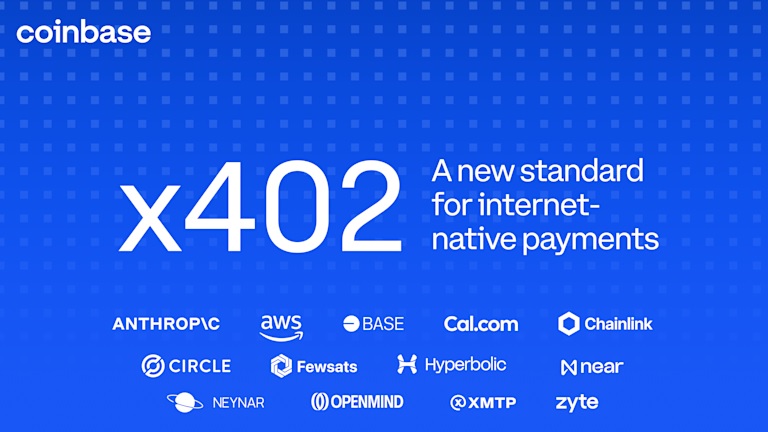
Coinbase is launching x402, a payment protocol that enables instant stablecoin payments directly over HTTP. It allows APIs, apps, and AI agents to transact seamlessly, unlocking a faster, automated internet economy.
an article written by Erik Reppel, Nemil Dalal, Dan Kim
The internet economy has always struggled with payments.
Traditional payment rails—credit cards, bank transfers, subscriptions—were built for a pre-internet world. They’re slow, expensive, geographically limited, and riddled with manual steps. As digital interactions have scaled, payments have lagged behind: fragmented, sluggish, and hard to program.
There is a need for a more modern approach—one that supports autonomous AI agents, the rise of stablecoins and generally enables instant, frictionless payments native to the internet itself. Recently, Citi called this era the “ChatGPT moment” for payments, and a16z labeled it the “WhatsApp moment,” for stablecoins, reflecting a growing consensus: the world is ready for payment rails as seamless and global as the web itself.
At Coinbase, we’re addressing exactly this challenge by introducing x402: an open standard that leverages the original HTTP „402 Payment Required” status code to embed stablecoin payments directly into web interactions. This protocol draws inspiration from Balaji and team’s work on crypto micropayments with http://21.co many years ago. At the time, you could only achieve micropayments with Bitcoin payment channels, which required expensive setup/teardown. But with modern L2s like Base, onchain fees have dropped to 1 cent, so many of the applications they prototyped are becoming possible.
x402 lets developers and AI agents pay for APIs, services, and software directly with stablecoins over HTTP. With just a few lines of code, x402 offers built-in authentication, automatic settlement, and seamless integration into existing web infrastructure. It makes monetization instant and automatic, allowing businesses and agents to transact value as easily as they exchange data.
Erik Reppel, Head of Engineering at Coinbase Developer Platform and co-author of the x402 whitepaper, captures the vision behind this initiative:
“We built x402 because the internet has always needed a native way to send and receive payments—and stablecoins finally make that possible. Just like HTTPS secured the web, x402 could define the next era of the internet; one where value moves as freely and instantly as information. We’re laying the groundwork for an economy run not just by people, but by software—autonomous, intelligent, and always on.”
x402 is launching alongside leading collaborators including AWS, Anthropic, Circle and NEAR, who share our belief in an open, programmable internet economy.
Gagan Mac, VP Product Management at Circle—the issuer of USDC—sees x402 as a powerful new standard for making stablecoin payments a first-class citizen of the web:
“USDC is built for fast, borderless, and programmable payments, and the x402 protocol elegantly simplifies real-time monetization by removing friction around registrations, authentication, and complex signatures. Together, they unlock exciting new use cases like micropayments for AI agents and apps.„
And Illia Polosukhin, co-founder of NEAR and co-author of „Attention Is All You Need”—the paper introducing the architecture behind GPT—sees x402 as a natural fit for building seamless agent-driven experiences:
“Our vision merges x402’s frictionless payments with NEAR intents, allowing users to confidently buy anything through their AI agent, while agent developers collect revenue through cross-chain settlements that make blockchain complexity invisible.”
Together with these partners, we’re not just introducing a new payment standard—we’re building a foundational infrastructure for a digital economy that’s fast, programmable, and truly internet-native, powering experiences designed equally for humans and autonomous machines.
Why x402 Matters
Traditional payment methods aren’t just outdated—they actively hinder the internet economy.
Legacy payment systems like credit cards and bank transfers weren’t built for today’s fast, global, and automated internet. They’re slow, expensive, and riddled with geographical and authentication barriers. Even crypto solutions often require complex wallets or blockchain-specific tools, adding friction instead of removing it.
x402 solves this by resurrecting the HTTP 402 „Payment Required” status code, a dormant feature of the web designed for seamless payment requests within standard HTTP interactions. Now, clients—whether humans, scripts, or AI agents—can respond to payment prompts instantly using widely-used stablecoins (like USDC), making transactions as effortless as loading a webpage.
Specifically, x402 enables:
. Servers to instantly issue standardized 402 Payment Required responses for premium digital resources.
. Embedded, automatic payment instructions directly within standard HTTP responses.
. Seamless integration into existing HTTP infrastructure, eliminating the need for special wallet interfaces, layers, or separate authentication mechanisms.
The practical impact is clear: payments become instant, seamless, and embedded directly into the internet—unlocking new business models, frictionless global transactions, and fully autonomous software interactions.
More details here
Banking 4.0 – „how was the experience for you”
„To be honest I think that Sinaia, your conference, is much better then Davos.”
Many more interesting quotes in the video below: